St. George's, Bermuda
St. George's | ||
|---|---|---|
Town | ||
 St. George's harbour and town, seen from Fort George | ||
|
Overseas territory | ||
| Settled | 1612 | |
| Population (2016)[1] | ||
| • Total | 1,527 | |
| Climate | Af | |
| Official name | Historic Town of St. George and Related Fortifications, Bermuda | |
| Type | Cultural | |
| Criteria | iv | |
| Designated | 2000 (24th session) | |
| Reference no. | 983 | |
| Region | Western Europe (and North Atlantic) | |
St. George's (formally the Town of St. George or St. George's Town), located on the
Nomenclature
Bermudian convention, where a
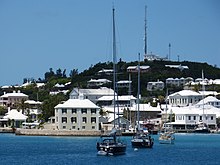
Among many examples of such place names in Bermuda are
The use of the possessive form is not exclusive, however, as exemplified by place names such as the names of most of the parishes (which – other than St. George's Parish – all commemorate historical people), such as
By example, Bermudians will always say St. George's and St. David's are the largest islands in St. George's Parish, and never St. George and St. David are the largest islands in St. George Parish. As many maps and other printed materials featuring Bermuda are produced abroad, it is extremely common to find maps, books and other material using the non-possessive forms, but visitors to Bermuda should be aware that using the non-possessive forms when speaking to Bermudians is likely to cause as much offence as saying "Bermudan" (although Bermudians, who pride themselves on politeness, are unlikely to respond rudely).
History

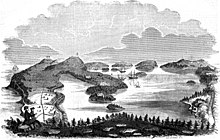
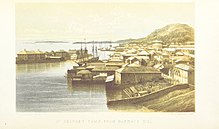
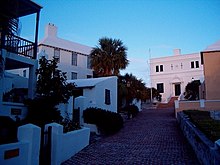
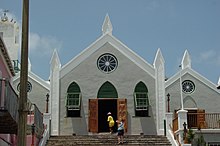

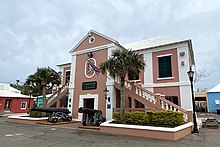
Originally called New London, St. George's was first settled in 1612. This was three years after the first English settlers landed on St. George's Island on their way to
Two men remained behind to maintain the company's possession of the archipelago (a third stayed when the Patience returned later that year). By the Virginia Company's Third Charter in 1612, the boundaries of the new colony were extended out to sea to include Bermuda. The company sent a party of 60 new settlers to Bermuda to join the three men left behind by the Sea Venture. After a brief period on neighbouring St. David's, the settlers started building structures at St. George's, located in a sheltered sound that kept ships protected from bad weather.
In 1615, the shareholders of the Virginia Company created a second company, the Somers Isles Company. It administered Bermuda separately until the company was dissolved in 1686. (The Virginia Company was dissolved in 1624).
This small town was the capital of Bermuda until 1815; it was linked to the history of colonial America. Ten thousand Bermudians emigrated, primarily to Virginia and the
As Bermuda's population centre, and only true port during this period, St. George's was connected to development in the North American colonies. During the
During the American Civil War, some British from St. George's evaded coastal blockades to provide supplies and munitions to the desperate Confederates. This trade was based in St. George's.
King's Square forms the centre of St George's, where regular 17th-century re-enactments are held throughout the year. Excavations carried out by
The town has numerous historical sites, such as the old
In 1996, the town was twinned with
Sports
Education
St. George's Preschool serves the area.[7]
St. George's Primary School is in the community.[8]
Notable people
- Charles Delucena Meigs (1792-1869), American obstetrician
- Robert John Simmons, who served in the Bermuda Garrison before dying of wounds as a First Sergeant in the 54th Massachusetts Infantry Regiment during the United States Civil War.
- Thomas Tudor Tucker (1745 in St. George's – 1828 in Washington, D.C.) was a Bermuda-born American physician and politician representing Charleston, South Carolina.
- John Hamilton Gray QC (1814 in St. George's – 1889 in Victoria, British Columbia) was a politician in the Province of New Brunswick, Canada, a jurist, and one of the Fathers of Confederation
- Reverend Robert Ashington Bullen FLS, FGS, FZS, FRAS (1850 St. George's – 1912 in UK) was an Anglican priest, a geologist and an authority on Mollusca
See also
- UNESCO World Heritage Site: Historic Town of St George and Related Fortifications, Bermuda
- History of Bermuda
Further reading
- Michael Jarvis, Bermuda's Architectural Heritage: St. George's (Bermuda National Trust, Hamilton, 1998)
References
- ^ "Bermuda 2016 Census" (PDF). Bermuda Department of Statistics. December 2016. Retrieved 22 March 2020.
- ^ Bermuda Police Service: History. The Early Years: The Death Of Anna Skeeters
- ^ "The Bermudian magazine: The Skeeters Murder. By Sandra Campbell. 15 March, 2013". Archived from the original on 4 March 2016. Retrieved 15 October 2015.
- ^ "Abbot's Cliff, Bermuda – Geographical Names, map, geographic coordinates". geographic.org.
- ^ "The St. George's Foundation". stgeorgesfoundation.org.
- ISBN 1-58980-087-7
- ^ Home Archived 27 March 2020 at the Wayback Machine. St. George's Preschool. Retrieved on September 14, 2016.
- ^ Home[permanent dead link]. St. George's Primary School. Retrieved on September 14, 2016. "A fantastic little school in the heart of the historic town of St. George's, Bermuda."
External links
- St. George's Foundation
- St. George Bermuda – From Bermuda Attractions
- Town of St. George Archived 14 March 2007 at the Wayback Machine Detailed info from Bermuda-Island.net
- Bermuda online's St. George's page
- Webcam At Harbour Radio [1] (located at Ft. George, above the Town)
Gallery
-
St. George's Harbour, ca. 1864. Confederate blockade runners are visible.
-
The Unfinished Church
-
Entrance to The Tucker House
-
Statue of George Somers
-
View from the harbour
-
The Featherbed Alley Printshop Museum
-
Tucker House (housing a museum of the Bermuda National Trust), on Water Street and Barber's Alley
-
The St. George's Foundation's UNESCO World Heritage Centre on Penno's Wharf









